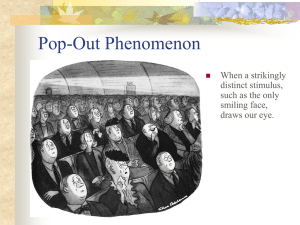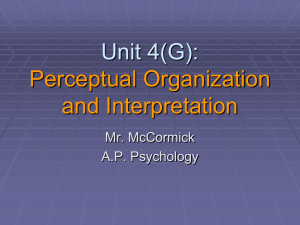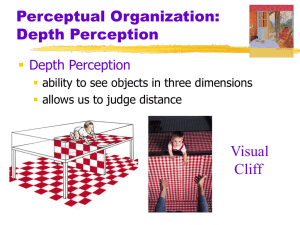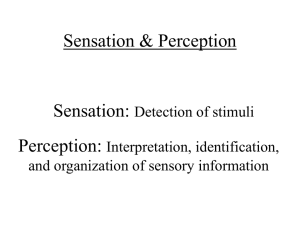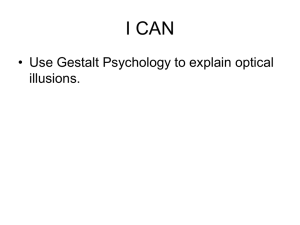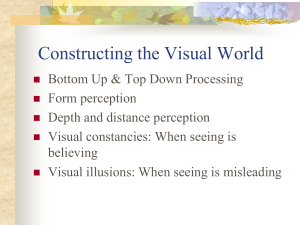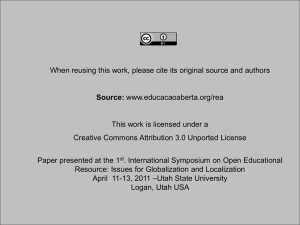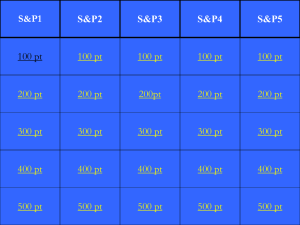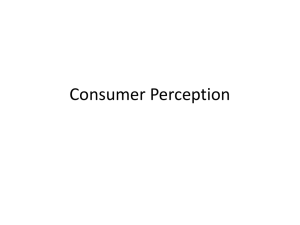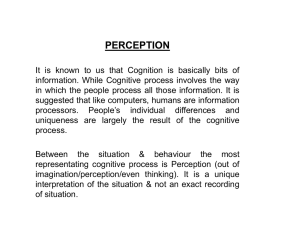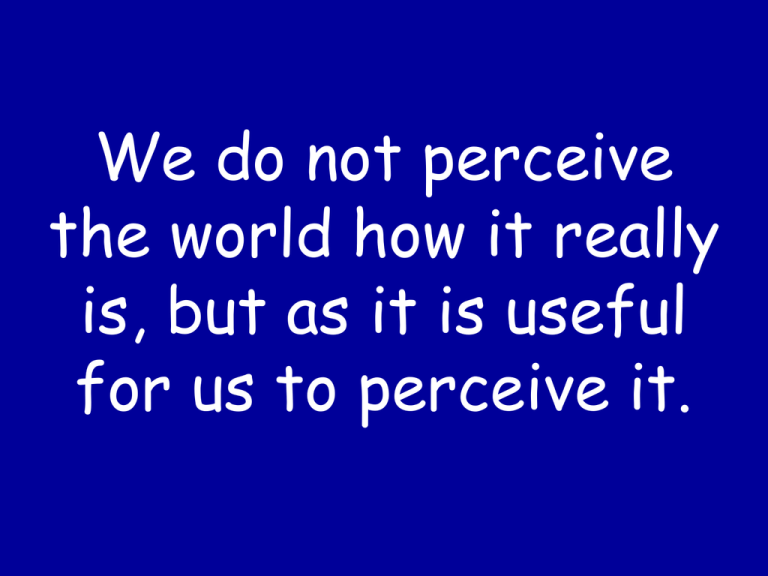
We do not perceive
the world how it really
is, but as it is useful
for us to perceive it.
Perception
The process of organizing and interpreting
information we get from our senses
•enables us to recognize meaningful
objects and events.
In transforming
sensations into perceptions,
we create the meaning
Perception
• The way we interpret the world in many
ways dictates our sense of reality
• Even if our senses are amazing, if our
perception is skewed we will not
understand the information we sense
Selective Attention
• Any moment we
focus our
awareness on
only a limited
aspect of all that
we experience
• Example–
directions video
Cocktail Party Effect
• Ability to attend
selectively to
only one voice
among many
Visual Capture
The dominance of vision
over other sense
modalities, such that what
is felt or heard conforms
to what is seen.
Perceptual Illusions
• Once we have attended to certain stimuli,
how do we organize them into meaningful
perceptions?
• Dalmatian Picture
Turn to page 234
Perceptual Illusions
Size-Distance Relationship
Both girls in the room are of similar height.
However, we perceive them to be of different
heights as they stand in the two corners of the
room.
Both photos from S. Schwartzenberg/ The Exploratorium
Ames Room
The Ames room is designed to demonstrate the sizedistance illusion.
Lightness Constancy
The color and brightness of square A and B are the same.
Thanks Noodle
Perceptual Illusions
Perceptual Illusions
Perceptual Illusions
Perceptual Illusions
Visual Capture
• When vision competes with other senses,
vision usually wins- known as visual
capture
• For example- watching a movie, in theatres we
believe the sound is coming from the screen
where people are talking, when really, it’s not
Perceptual Organization
• To transform sensory information into
meaningful perceptions, we must organize
it: we must perceive objects as distinct
from their surroundings, see them as
having a meaningful and constant form,
and discern their distance and motion.
Perceptual Organization
When vision competes with our others senses, our vision
usually wins – a phenomenon called visual capture.
How do we form meaningful perceptions from sensory
information?
We organize it. Gestalt psychologists showed that the
brain creates a coherent perceptual experience that is more
than simply a sum of the available sensory information,
and it does this in predictable ways. Gestalt psychology
examines a person’s total experience because the way we
experience the world is more than just an accumulation of
various perceptual experiences.
Gestalt
• German scientist became intrigued with
how the mind organizes sensations into
perceptions
• Given a cluster of sensations, the human
perceiver organizes them into a gestalt
• Described principles by which we organize
our senses into perceptions
Gestalt Psychology
• Gestalt means “an organized whole”
• These psychologists were concerned with how and
why we GROUP objects together.
• They stated that humans can not help but
perceive stimuli in groups rather than individual or
isolated elements
This explains why we see
a cube and not a set of
isolated holes or circles
Perceptual Organization: Gestalt
Grouping
the perceptual tendency to organize stimuli
into coherent groups
Grouping Principles
proximity--group nearby figures together
similarity--group figures that are similar
continuity--perceive continuous patterns
closure--fill in gaps
connectedness--spots, lines, and areas are
seen as unit when connected
Remember?
• Our yen for assembling visual features into
complete forms involves bottom-up processing,
starting with entry-level sensory analysis, as well
as top-down processing that uses our
experiences and expectations to interpret those
sensations
• Remember- our brains do more than just
register information about the world. We
constantly take in information and infer
perceptions that make sense to us
#
Which one is better looking?
Perceptual Organization
Figure and Ground--organization of the visual
field into objects (figures) that stand out from
their surroundings (ground)
Perceptual Organization:
Grouping Principles
Proximity
• We group
nearby
figures
together.
Proximity
• Grouping nearby figures together
3 sets of parallel lines not six separate lines
Similarity
• Figures similar
to each other
we group
together.
Similarity
• Grouping together figures that are
similar to each other
9 separate shapes
Or
Two columns and one
Column?
Continuity
• We perceive
smooth,
continuous
patterns rather
than
discontinuous
ones
Continuity
• Perceiving smooth continuous patterns
not discontinuous ones
Connectedness
• When they are
uniform and linked,
we perceive spots,
lines, or areas as a
single unit
Perceptual Organization:
Closure
We fill in
gaps to
create a
complete,
whole
object
Closure
• Filling in gaps to
create a
complete, whole
object
Perception
Our perceptions are affected by the
biology of our sensory systems, but
also by our previous experiences and
cultural expectations.
Or in other words our…
Schemas
Perception is also often based on…
Perceptual Set
A bias to perceive one thing and not another
when looking at things in our world
Sort of the same thing as a mental set
So in some ways it can cause us to make errors in
judgments when we are trying to perceive the world
through our senses
What do you see?
• What you see in the center is influenced by
your perceptual set
Perceptual Set
Bill Clinton and who?
Perceptual Set-Schemas
Which is the real Madonna?
Perceptual Set-Schemas
• When we hold the eyes as a constant it is difficult
to identify the correct Madonna. Now that the
image is rotated it is easy to tell the difference.
Perceptual Illusions
Used to reveal how we normally organize and
interpret sensations
Optical or Visual Illusions
Discrepancies between the appearance of a visual
stimulus and its physical reality
Form Perception
• Figure-Ground
Relationship
• When we look at objects we
see the object as the figure
and its surroundings as the
background
– Airplane in the sky
Depth Perception
The
ability to see objects in three
dimensions although the images that
strike the retina are two dimensional.
Allows us to judge distance.
Perceptual Organization
Depth Perception
Visual Cliff
Used to test infants depth perception
Perceptual Organization: Depth
Perception
Depth Perception
ability to see objects in three dimensions
allows us to judge distance
Binocular cues
retinal disparity
images from the two eyes differ
closer the object, the larger the disparity
convergence
neuromuscular cue
two eyes move inward for near objects
Perceptual Organization: Depth
Perception
Monocular Cues
relative size
smaller image is more distant
interposition
closer object blocks distant object
relative clarity
hazy object seen as more distant
texture
coarse --> close
fine --> distant
Perceptual Organization: Depth
Perception
Monocular Cues (cont.)
relative height
higher objects seen as more distant
relative motion
closer objects seem to move faster
linear perspective
parallel lines converge with distance
relative brightness
closer objects appear brighter
How do we transform twodimensional objects to threedimensional perception?
Binocular
Cues:
depth cues that depend on two eyes
•Monocular Cues:
•depth cues that depend on one eye
Binocular Cues
Convergence
eyes turn in as objects get close
Pen together two eyes- try
with one
Binocular Cues
Retinal disparity (or binocular disparity): Images from
the two eyes differ. Try looking at your two index fingers
when pointing them towards each other half an inch apart
and about 5 inches directly in front of your eyes. You will
see a “finger sausage” as shown in the inset.
Monocular Cues
Tricks that we use to judge depth
perception
What makes them monocular is that
you need only one eye to use them.
So if you lose one eye in a tragic ping-pong
accident…don’t worry…just wear an eye
patch
Monocular Cues
Relative Size: If two objects are similar in size, we
perceive the one that casts a smaller retinal image
to be farther away.
Monocular Cues
Interposition: Objects that occlude (block) other
objects tend to be perceived as closer.
Rene Magritte, The Blank Signature, oil on canvas,
National Gallery of Art, Washington. Collection of
Mr. and Mrs. Paul Mellon. Photo by Richard Carafelli.
Interposition
if something is blocking our view, we perceive it as
closer
Monocular Cues
Relative Height: We perceive objects that are higher in our
field of vision to be farther away than those that are lower.
Image courtesy of Shaun P. Vecera, Ph. D.,
adapted from stimuli that appered in Vecrera et al., 2002
•Relative Size
if we know that two objects are similar in size,
the one that looks smaller is farther away
Relative Size
Monocular Cues
Relative motion: Objects closer to a fixation point
move faster and in opposing direction to those
objects that are farther away from a fixation point,
moving slower and in the same direction.
Motion Perception
What tools do we use to perceive
motion…
Stroboscopic movement
Perceiving continuous movement
Example
• Movies
Flip Book Example
Monocular Cues
Linear Perspective: Parallel lines, such as railroad
tracks, appear to converge in the distance. The
more the lines converge, the greater their
perceived distance.
Linear Perspective at Work
Monocular Cues
Light and Shadow: Nearby objects reflect more light into
our eyes than more distant objects. Shading can imply
where a light source is and thus imply depth and position.
The ones that are shaded on the left seem to be sticking out
towards us.
From “Perceiving Shape From Shading” by Vilayaur
S. Ramachandran. © 1988 by Scientific American, Inc.
All rights reserved.
Linear Perspective
Parallel lines seem to converge with distance.
Phi Phenomenon
• An illusion of movement created when two or more
adjacent lights blink on and off in succession.
Perceptual Constancy
Perceptual Constancy
Perceiving objects as unchanging even as light and retinal
images change
Shape and size
Lightness
Color (indoor vs. outdoor)
Re-Cap of Perspective:
Perceptual Constancy
Perceptual Constancy- Tendency for perceptions
of objects to remain relatively unchanged in spite
of changes in raw sensations
Brightness Constancy: piece of white paper does not
change when it moves from am dimly lit room to a
brightly lit room
Color constancy: colors do not seem to change much
in spite of different conditions of light
Size constancy: dollar bill from 1 foot and 10 feet with
seem different in size, however we do not perceive it
as different because familiar objects do not change in
perceived size as different distances
Shape constancy- a penny seen straight on is
circular, from an angle it’s oval however we continue
to perceive it as circular
Re-Cap: Depth Perception
Texture Gradient- texture of objects more severe
up close
Linear Perspective- images cast smaller images
on retina when they are more distant, parallel lines
appear to grow closer further away
Superposition- Closer objects tend to be partially
in front of distant objects
Shadowing- shadow suggest depth of object
Speed of movement- objects further away move
across the field vision slower
Aerial Perspective- distant objects look hazy
Accommodation- shape of lens of eye changes
to focus on visual images
What does this say?
Bottom-up Processing
Analysis of the stimulus begins with the sense
receptors and works up to the level of the brain
and mind.
Letter “A” is really a black blotch broken down into
features by the brain that we perceive as an “A.”
Top-Down Processing
Information processing guided by higher-level
mental processes as we construct perceptions,
drawing on our experience and expectations.
THE CHT
Call me….
703-855-78S2
Top-Down vs. Bottom Up
Top-Down Processing
Aoccdrnig to rscheearch at Cmabrigde
Uinervtisy, it deosn’t mttaer in what
oredr the ltteers in a word are, the olny
iprmoetnt tihng is that the frist and lsat
ltteer be at the rghit pclae. The rset can
be a toatl mses and you can still raed it
wouthit a porbelm. This is bcuseae the
huamn mnid deos not raed ervey lteter
by istlef, but the word as a wlohe.
Philosophers have debated
the origin of our perceptual
abilities:
Is it nature or nurture?
What do you think?
Beliefs
• German philosopher Immanuel Kantknowledge comes from our inborn ways of
organizing sensory experience
• British philosopher John Locke- through
our experiences we also learn to perceive
the world
Could a person who is blind from
birth distinguish this visually if they
gained sight as an adult?
Critical Period
• Critical period of vision is at birth through
infancy of humans, cats, monkeys
Cataracts
• Human infants born with opaque lens
(cataract) will typically have corrective
surgery within a few months
• Brain network for corrected eye develops
quickly, enabling vision to occur normally
Perceptual Adaption
• With vision, the ability to adjust to an
artificially displaced or even inverted visual
field
– Example: wearing a new pair of glasses (may
be fuzzy at first, a few hours or days, eyes will
adjust)
Human Factors Psychologists
• A branch of psychology that helps to
determine how appliances, machines, etc.
should be created in order for people to
use them naturally
Is it really possible?
Extrasensory Perception
• ESP (extrasensory perception)
– The controversial claim that perception can
occur apart from sensory input
• Parapsychology
– The study of paranormal events such as
– Telepathy – mind-to-mind communication
– Clairvoyance – perception of remote events
ESP
Three types of ESP:
1. Telepathy- mind to mind communication
2. Clairvoyance- perceiving events as they are
taking place
3. Precognition- perceiving future events
Also associated with ESP, psychokinesis (“mind over
matter”
Claims of paranormal
phenomena include
astrological predictions,
psychic healing,
communication with the dead,
and out-of-body experiences
• http://viscog.beckman.illinois.edu/djs_lab/d
emos.html
• www.grand-illusions.com
• http://www.mindhacks.com/
• http://psych.hanover.edu/Krantz/tutor.html
• http://users.skynet.be/J.Beever/pave.htm
• http://philomel.com/musical_illusions/
• http://www.audiodesignline.com/20430042
9

